Sujata Massey's Blog, page 5
August 11, 2023
Summer’s Surprising Path
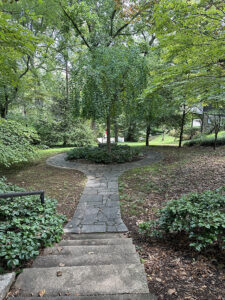
My summer started out with grand plans: cross country travel for a book tour, and a chance to catch up with family and friends in the Midwest and West. But life throws you curveballs, doesn’t it? And my shocker was a big fat COVID-19 infection that occurred when I flew out of California back to the East. The result has been a blessedly mild, but long-lasting illness.
In third week of quarantine, I spend most of my time on my Victorian home’s two sleeping porches—an architectural feature created as a response to the era’s contagious, often lethal, epidemics. I’m grateful that none of the successive homeowners thought to remove these outdoor havens, where I to eat my meals, read books, work on my writing, and log onto PBS to watch Grantchester. But not all the time. The soft focus of nature distracts me toward something better: the young squirrels chasing each other up and down the trees. After I’ve watched them while having morning coffee, I slip downstairs and out to the garden to do some weeding.
My attempts to bring my renegade rudbeckia into order remind me of the magical time I had exploring gardens this spring and summer with friends. These green spaces still hold a place in my mind that stands for freedom, imagination, creativity and health.
One of my favorite places to wander is Mt. Cuba, a historic estate in Delaware owned by a late DuPont heiress and her family and now turned over to a trust. The goal of Mt. Cuba is the development of attractive and sturdy cultivars of local native plants—and sharing with visitors ways to design beautifully with natives. Here’s a glimpse of how the native can be elegantly landscaped along a curved walkway.

While visiting Minnesota in both spring and summer, I rambled around Lake of the Isles, which sits between Kenwood and Lowry Hill and Uptown neighborhoods. The path around the lake is just over three miles, completely flat and with separate trails for walkers and bicyclists. The surrounding parkland once was landscaped with the fashionable imported plants of the era; roses and the like. In this century, native plants have slowly grown and stabilized. The water might be cold, but Lake of the Isles is the beating, warm heart of my memories of life a decade ago in Minneapolis.

The Golden State has its own weather zones that have been going haywire in recent years. During my July visit, Southern California was blisteringly hot, and San Francisco was uncharacteristically sunny and pleasant (though its residents still wore down jackets, expecting the usual). My friend Sue drove me to across the East Bay to visit Filoli, a foundation-owned garden and historic house in Woodside. The name was made up to represent these ideas: Fight, Live, Love. Rather intense; could it have been inspired by Great War?
The grand Italianate mansion was designed by the architect Willis K. Polk, starting in 1915, for William and Agnes Bourn. Mrs. Bourn hired a female floral expert to install their gardens–a growing trend in the era of famous professional and private gardeners like Edith Wharton, Gertrude Jekyll, Elizabeth von Arnim and Vita Sackville-West. Bella Worn, who came from an elite local family who’d lost their fortune, had both an instinctive understanding of flowers, and significant experience owning at a floral business with her two sisters. As a garden designer, Bella was reputed to have the toughness and confidence to get her way on plant decisions every time. Bella spent most of the 1920s driving out to Filoli in a chauffeured car once a week, instructing every planting and pruning on the property, and then socializing with the elite in the evening. I picture her as the perfect heroine for a traditional mystery series set amongst the robber barons of California.

In the Roaring Twenties, twelve gardeners reported to Bella Worn. Today, fourteen horticulturists maintain the grounds for visitors’ pleasure. Filoli’s gardens are laid out in a series of outdoor rooms, a popular design for landed gentry in the early 20th century. As Sue and I explored the many paths, I found myself exclaiming about the gorgeous surprises appearing with each turn we took. Soft drifts of color rolled in waves, creating vistas both abundant and soothing.


Temperatures were in the high 80s during our visit to Filoli. Despite the heat, I noted elegant frocks and the crisp suiting worn by many visitors. These glamorous young people set out elaborate picnics and posed against the vivid floral backdrops. Truly, the only missing element was a tuxedoed waiter carrying champagne cocktails—and perhaps shrimp cocktail on ice. How quickly I had lost my grasp on reality!
And that is the value of historic gardens.

The post Summer’s Surprising Path appeared first on Sujata Massey.
July 12, 2023
The Mistress Hits the Road
This post originally appeared on Murder Is Everywhere.
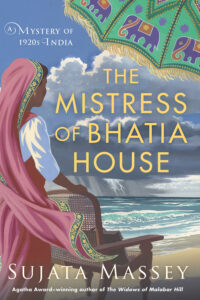
Today is the day I’ve been awaiting for a long time—well, for at least several years! The Mistress of Bhatia House has emerged from seclusion and is now book-touring her way across the USA.
My novels usually carry titles that mention a person’s role—say, a widow, a prince, a daughter, a wife. Or, I am drawn to having a place name in the title. Although I have titled just about every book I’ve written, this time, the title idea was presented by my publisher, Soho Press. I was stunned by it and instantly realized that t it was so much better than my original idea (Death in Ghatkopar).
So what does it mean? Bhatia is a clan surname that stretches from Pakistan throughout India. So it’s not tied to one region, because Bhatias were merchants set down roots in many places. One of my dearest friends is a Bhatia whose family are Punjabi. When I was signing books tonight at Politics & Prose In Washington D.C., I met a Western woman married to a Gujarati Bhatia husband. And she was wearing great Indian jewelry!
The Bhatia House referred to in the title is the name of the fictional compound where a Gujarati merchant family lives. It’s in a place called Ghatkopar, a village close to Bombay. And so who’s the mistress? This was what my interlocutor asked me right away. Now, the obvious choice for “Mistress” of Bhatia House is Uma Bhatia, the senior ranking woman in the household. Uma’s sister-in-law, Mangala Bhatia, a competitive sort who’s to undermine Uma and put her own children ahead. But I want the reader to wonder if Oshadi, an elderly head female servant at Bhatia House, might be the mistress I’m thinking of. And there’s a second female servant, Sunanda, who might be the mistress of one of the household’s men.
It has felt thrilling to be signing books in a store this summer. On Wednesday I’m flying out to Minneapolis, MN and continuing to California, then back in Pennsylvania, and ending the celebration with signings beach towns in Delaware and Maryland. (Yes—I am stalking readers where they might be off duty!)
And last but not least, I hope to be in India this fall to visit readers who have access to the Penguin Random House India edition. Also, an audiobook is out, with narration by the fantastic Sneha Mathan, who has read three previous books by me. Details about my stops are on the events page of my website.

I am humbled by the warm reception this book is getting, and I am grateful to my comrades at Murder Is Everywhere for the years of support it took to finish this book. And to you also—dear readers. Your enthusiasm for crime fiction set around the world has taken our manuscripts out the drawer and created a thriving genre.
The post The Mistress Hits the Road appeared first on Sujata Massey.
June 28, 2023
Carving Up a Bombay Duck: How I Edit
This post originally appeared on Murder Is Everywhere.

Surely, every writer has a different equation of how much writing they leave as is—and how much they willingly alter. Fine tuning is a major part of my work these days, and it’s every bit as challenging for me as getting the first draft on paper. For my upcoming book, two editors read my manuscript and inserted line by line queries. After they finished, a copy editor and a proofreader got to it. A lot of focused, analytical minds catch inconsistencies and errors, and I’m grateful.
Before one of my novels goes into print, I rewrite it three or four times. I dwell the most on the line-edit draft. A line-edit happens after a book has been edited by a content editor with suggestions for theme and consistency and suggested changes in direction. Now the same editor—or an assisting editor—goes word by word, flagging repeated words, inconsistencies, and the like. When I submit a 425-page manuscript, and each page averages at last three editing marks, that means there are more than 1200 points for me to deliberate over (or should it be, “over which to deliberate”?) In Microsoft Word, color changes in the text highlight anything that has been rewritten by an editor. Any comments appear in thought balloons on the margin.
All kinds of things that looked smashing and tight when I sent off that draft to be line-edited appear rambling and poorly worded to me on close reflection. And then, when I rewrite one sentence, it usually leads to a string of changes due to new ways of thinking; changes that my editors didn’t expect and now need to edit again! And I create more work for myself because upon this third-or-so reading, I start to wonder if I got the research right.
Here’s an example of how I might go into overdrive on an edit. Let’s look at what I’d call the “Bombay Duck” scene in my forthcoming Perveen Mistry novel, The Mistress of Bhatia House.

Bombay Duck is the Anglo-Indian nickname for a species of lizardfish called Harpoon Nehereus in Latin, and boomla, bummalo, bombil whose habitat is tropical areas of the Indian and Pacific Oceans. They are best know for being fished in Maharashtra, the state that was known in colonial times as Bombay Presidency. Some have suggested that the nickname is related to “Bombay daak,” a famous train of that British ruled era, but that doesn’t seem particularly likely, because people started calling the fish this name before that long distance train existed. It was eaten locally in a number of ways, and it was also canned for export.
So I asked myself, how much of the above information does the reader need to know? And would this fish—which is not as universally enjoyed as say, shrimp or lobster—actually have been served at the Taj Hotel in the early 20th century?

I recalled how two years earlier, I’d walked the halls of the 1903 Taj Mahal Palace hotel with Nisha Dhage, their PR and Marketing director. Nisha had pointed out some of the original dining room menus posted in an archive gallery. I’d snapped a photo of a menu, but it didn’t include Bombay Duck. However, I dug out a history of the Taj Hotel, which did show another menu with Bombay Duck included. That point was sound—but there were other matters to consider.

This is what I originally wrote:
Alice was already studying the menu. “I think I’ll take the Bombay Duck. Will you share? And I’m thinking about Pommes Anna, in case the duck doesn’t come with rice.”
“Yes.” Perveen ran her eyes down the listed dishes. “It depends on whether they are going to make the fish European or Indian.”
The Taj occupied a special place in Bombay. Not only was it the city’s most luxurious hotel, it was built by a Parsi, Jamsetji Tata, who adored The Continent. The menu steered French and Italian.
The waiter arrived late, only after Alice had raised her arm to flag him.
“And how is the Bombay Duck served?” Alice inquired.
“Breadcrumbs fried.”
“That’s it?” Perveen asked. She was accustomed to it prepared many ways, but always with spices and fresh green chili.
“White sauce option.”
“Never mind,” Alice said. “I prefer it cooked in toddy, and with chiles. The Indian way.”
“This is a continental restaurant, madam. My apologies.”
“This is a lovely place,” Alice reassured him. “I’ll take the chilled shrimp cocktail, Chicken Americaine, Potatoes Anna and Salade Lyonnaise. How about you, Perveen?”
Can you guess the rabbit hole I found after reading this? I was compelled to doublecheck the recipe that Alice believes to exist. I went to one of my favorite references, The Essential Parsi Cookbook, written by Bhicoo Manekshaw (1922-2013). I found ten recipes for boomla!
I also wondered: do these fish run during the month of June, prior to rainy season? That’s the time of the novel. Mrs. Manekshaw had no comment on boomla season, so I went to the internet and came away with the impression that they are widely available April to September.
And there was the matter of the waiter, who barely appears at all. The unimportance of people who serve is what I dislike about a lot of British colonial fiction about India. So, I’d have to take care of that. by the same token, I needed to decide Alice’s annoyance about food to remain. An Englishwoman who’s never boiled an egg probably wouldn’t know so much about an Indian dish.
I decided I’d better leave the critical questioning to Perveen.
So here’s the rewrite:
When Perveen reached the Garden Room, she told the maître d’ that Alice would be arriving shortly after her. The maître d’ apologized that lunch orders would be ending in twenty-five minutes and only one table for two was left—close to the hotel wall, not the center of the garden. Did she mind?
“Thank you very much!” Perveen said, glad for the shade and greater privacy this table provided. A young man dressed in white coat with a banded collar and black trousers dashed over from the next table to take her drinks order: a sweet lime for Alice, and salt-lime for herself, both with plenty of club soda and ice. Within ten minutes, the waiter was back with the drinks, and Alice rushed up, face pink from exertion, with wet hair hanging lank to her shoulders.
“You are her guest?” The waiter quickly pulled out the chair for Alice, almost toppling as she moved forward to take her seat.
“Yes. Sorry to look like a drowned rat—I had to race to be first in the showers.”
Perveen laughed. “I rather the think his surprise was because of your missing chapeau.”
She clapped her hand to her crown. “I must have forgotten the damned boater hat in the changing room.”
“Never mind. Just look at the menu—I want to get in the orders before lunch service ends.”
The Taj’s menu steered toward France and sometimes Italy; there were only a handful of Indian dishes on the menu. Given the heat, both women opted for a chilled shrimp cocktail and Salade Lyonnaise. Perveen selected a dish she’d never heard of called Chicken Americaine. Alice inquired about the ingredients contained in the day’s special, a fish called Boomla that bore the Anglo-Indian name “Bombay Duck.”
“Breadcrumbs fried,” the waiter answered, as if he’d said it a thousand times.
“That’s it?” Perveen asked, disappointed. The small, scaleless fish that belonged to the lamprey family was typically cooked with many spices.
“This is a Continental restaurant, madam.” The young man gave her a faintly reproving look.
Alice shrugged. “And a very good restaurant, too. I’ll try it. And did I spy a Black Forest cake on the sweets trolley?” when I came in that you’re now offering Black Forest Torte?”
“Yes, memsahib. I shall set aside a slice of the torte for you. And as for you?” The waiter turned to Perveen.
“No pudding today, thank you.” She had the urge to look at her watch. It felt like the day was being whiled away, when she had so much work trouble to think about.
The waiter recited the order, and when the ladies had nodded their assent, sped off to drop the bill at the next table.
“How interesting that a German cake is appearing on the Taj’s menu so quickly after the war,” Alice said. “In any case, I’m excited to taste chocolate. It’s a rare treat in India.”
I let this last part stand, even though the point about chocolate’s availability is no longer true!
The post Carving Up a Bombay Duck: How I Edit appeared first on Sujata Massey.
June 14, 2023
The Terrible Cloud
This post originally appeared on Murder Is Everywhere.

When the cloud came, I didn’t know what to expect.
The Mid-Atlantic Area is known as a middling kind of place. It serves up four seasons, none unduly extreme. My city, Baltimore, usually has a hot and humid summer, but quite bearable. The area doesn’t have the disaster experience connected with the Caribbean, Asia, and parts of the U.S. like California and the Mississippi Delta.
So last week, when the smoke from wildfires in Nova Scotia clouded our skies for almost a week, it was a shock. The sky wasn’t blue anymore—it was a kind of grayish. It’s hard to believe the picture of Baltimore’s Inner Harbor above is in color!
Just to the south of us in Washington DC, the cloud of smoke obscured the monuments.

New York City got the temporary rating of “worst air in the world’ last week. And the sky there went orange.

I went out for a short look around one evening in Baltimore. The sky seemed to be vibrating, and I realized I was witnessing the falling of almost invisible particles of smoky air. The thickness of the downpour reminded me of a blizzard. Back inside, I showered, but I could not wash away the feeling of dread.
A lot of people with asthma felt their throats close after just a few moments outside. I don’t have that illness, yet my breathing was uncomfortable. The birds weren’t singing as much—and it being a new baby bird season, I worried about the tiny avian airways. Our dog walker sent us a list of danger signals for asthma and respiratory problems that dogs can experience. Daisy’s walks shortened to 5 to 10 minutes, and I wore a mask.
All over the East Coast, swimming pools closed, and so did parks and zoos. The gutter cleaners didn’t come, and lots of people who do outdoor work had their jobs cancelled for reasons of safety. I postponed a planting event that I wanted to work with someone in my yard and instead concentrated on watering the hundred or so native seedlings that I’d put in the previous week. I And of course, it hadn’t rained for weeks.
Drought is often a contributor to bad air events. The “dust bowl” years of the 1930s in the Great Plains were tied to four separate drought events, making the topsoil of aggressively farmed prairie land blow great distances. The photo below shows the drama of the clouds in Kansas in 1935.
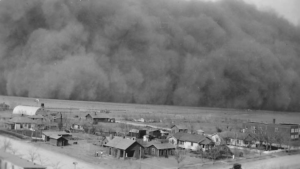
Nova Scotia was also suffering from drought, and the increase in temperatures globally conspired to give longer and wider burning time for the wildfires that occur there naturally every summer. And we’ve had drought in Maryland, too, without rainfall for weeks. The first drops finally fell this past Monday, building into a tumultuous downpour that gave us back our first “good air” day—and what looks to be a resolution of this crisis in Maryland.
And that’s for the time being. Global warming means more episodes like this, more changes in the way we live.
The post The Terrible Cloud appeared first on Sujata Massey.
May 17, 2023
Old Money Life on Summit Avenue
This post originally appeared on Murder Is Everywhere.

What would it have been like to be a mischievous teenager, living in your parents’ mansion in St. Paul, Minnesota, during the roaring twenties? It sounds like I’m talking about an escapist YA novel. The truth is, the 1927 diary of such a girl exists. To my great fortune, I stumbled onto a newly published version of a year in the life of Clothilde “Coco” Irvine while I was enjoying a short stay on Summit Avenue in Saint Paul, Minnesota. I bought the published book in the gift shop in the James J. Hill House, just up the road from her old home, which is now where the Governor of Minnesota resides.
 Governor’s Residence
Governor’s Residence
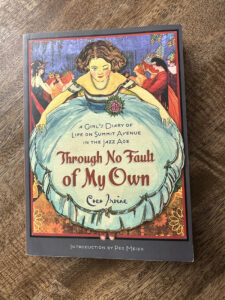
During my time in Minnesota, I was struck by how below-the-radar fabulous it is. Minnesota is regarded by the most of the U.S. as a flyover zone. But the truth is, it was a major player in the development of cross-country commerce, thanks to the Mississippi River, and the railroad empire built by St. Paul resident James J. Hill.
When I was a child in St. Paul, Summit Avenue was always an intersection I passed through on the way to the airport or a good restaurant or bookstore. This time, I got to drive its full four and a half miles, and the farther east I traveled along Summit, the closer I got to the Mississippi River and St. Paul’s origin story.
St. Paul started off as the home of Ojibwa and Dakota people, who lived along the Mississippi River for an estimated 12,000 years. Fur trappers from France and French Canada traveled into Mini Sota Makoce in the 1600s. As Minnesota became a territory under the control of the United States, the importance of the Mississippi River for transport of goods outplayed fur. After treaties were signed in 1851, most Native Americans were forced out of St. Paul, as well as Minneapolis, and the Anglo transformation began. The name came from a Roman Catholic missionary who expanded a rudimentary Catholic chapel first established on the bluff into a church, later the St. Paul Cathedral. In the Cathedral Hill neighborhood, of which Summit runs like an elegant, wide artery, showcasing extravagant Victorian stone and brick homes built for the families of James J. Hill, Frederick Weyerhauser, and many long-forgotten lumber barons.


Summit Avenue had its start in the 1850s, but its magic moment arrived in the 1880s and lasted through the roaring twenties. During this time, so much money flowed that architects and skilled artisans emigrated from Germany and England to assist socially mobile homeowners wanting a special touch of class.

 A German artist made $1/hr carving wood for James J. Hill
A German artist made $1/hr carving wood for James J. HillCoco Irvine Moles (1914-1975) grew up at 1006 Summit in a wide Tudor-style brick manor. In 1910, when Horace Hill Irvine, a lumber baron, had the house built for his six-person family, this section of Summit was still mostly open land. Yet soon the family was surrounded by neighbors. On nearby Grand Avenue, there lay the temptations of bustling urban life.
 Coco and her little sister Olivia
Coco and her little sister OliviaCoco was frequently called incorrigible by older family members and teachers. In her diary, she pours out her upset about the reactions she gets from her elders, although she was wildly popular with other kids. She especially got into trouble with her older brother Tom. One hilarious escapade was when they hid under a draped table on the family porch in order to run garden sprinkler water on all the guests’ feet. And there was a night that Coco and Tom sneaked out to go dancing at a nightclub. Before leaving the house, Coco dressed to the nines in her mother’s clothing and applied heavy makeup. There are many more “just between us” recountings, including a dangerous capsize while sailing on White Bear Lake, and kissing games.
Despite her charmingly written diary, Coco never became a professional writer, or did any sort of work. She graduated from Vassar and married well. Yet in the book’s afterward by Peg Meier, we come to understand the hardships she endured in adulthood. I wish she’d finished Vassar and become a writer instead of jumping into marriage. Or done both!
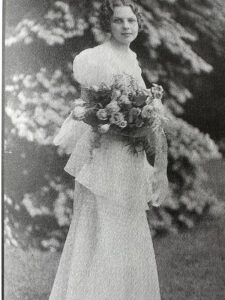 Coco at her Summit School graduation
Coco at her Summit School graduationOne very famous writer who did just that also grew up along Summit Avenue during the same era. I’m talking about F. Scott Fitzgerald. Fitzgerald was born in St. Paul, moved away briefly to New York, came back at the age of eight and grew up in his grandparents’ house on Laurel, which intersects Summit. He also lived in a rented gothic brownstone at 599 Summit after finishing Princeton and his World War I service. Here he wrote his debut, This Side of Paradise, which was published in 1920 and became a bestseller. It features scenes in the University Club, also located on Summit Avenue, and describes the adventures of rich young people socializing in clubs and along the frozen lakes in winter.
One of the few homes open to the public on Summit is the James J. Hill House. My third day of the visit, I walked five minutes from the Davidson and through the open gate to a Richardsonian Romanesque mansion which, at 36,000 feet, once was the largest residence in Minnesota. Before the Minnesota Historical Society got it, it had been gifted by the Hills to the Catholic Archdiocese. Because of that previous status, it’s devoid of most of the Hill furniture, and also had to be refurbished. Most of the Hill family’s furniture is in the homes of its descendants, not here. Still, it was a fascinating tour showing off splendid architecture and artifacts that gave context to Minnesota history and the Hill family’s rags-to-riches saga.


A grand dining table that is original was laid with old silver-plate sourced from Goodwill. It’s a good thing it wasn’t sterling, because a dessert spoon recently disappeared during tour hours.
I was happy to see James J. Hill’s desk from his St. Paul office was placed in the house. Of modest size and materials, it was nonetheless the place from where a railroad empire grew.

Large, grand, and comfortable digs of this size cost about $991,000 in 1891. Naturally, such a home’s maintenance required a large staff of servants. During winter, 2 tons of coal a day were delivered to feed the furnaces, and there were other lavish innovations such as huge blocks of ice delivered regularly and set into the walls of chambers to ensure refrigeration, and an elaborate security system to foil thieves. If you’ve watched The Gilded Age miniseries, you can see many parallels between the show’s Russell family and the Hills.
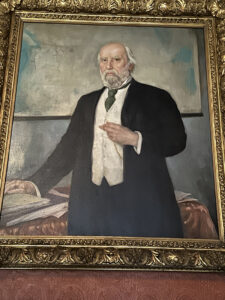 James J. Hill
James J. HillI stayed at the Davidson Hotel located at 344 Summit. The building, pictured below, is a stately golden brick manor built at a cost of $40,000 in 1915 for Watson Davidson, a farm boy who expanded his family’s small real estate holdings by purchasing commercial property and agricultural land in the United States and Canada. Watson married Sarah, the daughter of a steamboat commodore who himself had made a fortune operating more than 50 steamboats in the upper Mississippi. The couple had five children. After the Davidsons moved on, their house went through several incarnations including serving as an arts college. Although it’s now a hotel, it’s run in the style of an Airbnb with management reachable by phone, rather than in person, and entry to the house and one’s suite by passcode. You could almost pretend it was your own house.

The mansion is vast, with an imposing wide, curved wooden stairway. There’s an elevator, but a sign that says “No Riders.” The grounds outside are in the midst of renovations, although the house’s interior is immaculate. The ground floor boasts a beautiful library filled with vintage books, games, and antique furniture. The house itself has been divided into eight suites, all with private bathrooms, and some, like mine, with a sitting room that had sweeping views from the bluff over St. Paul and the Mississippi River.



The great number of mansions on Summit Avenue have largely been preserved, thanks to the work of old-house lovers taking on massive projects, and the area’s listing as a Heritage Preservation District. Yards were dated with SOS signs, and when I asked a resident about them, he explained that the city wants to build an elevated lane down the center of Summit for bicycle traffic. This is despite the fact that wide designated areas of the boulevard already are marked for biking traffic. Adding an elevated cement lane in the boulevard’s center will force the widening of the street and cause tree loss, perhaps up to 60 percent of the street’s beautiful canopy. And it could also cause accidents, which goes against the objective of the city.
I had only been on Summit Avenue for a few days, but I wanted to save it. I wrote about a number of reasons in my letter to the city of St. Paul, but there’s also a more selfish reason. Old-fashioned places are vanishing at a fast clip. The longest stretch of Victorian architecture in the United States is something to hold precious for everyone.
The post Old Money Life on Summit Avenue appeared first on Sujata Massey.
May 3, 2023
A Tree Grows in Baltimore, and So Does a Book
This post originally appeared on Murder Is Everywhere.

From where I sit, the view has changed. The windows which once offered views of my neighbors’ houses are now filled with nothing but green. The elms, oaks, and cherry trees have leafed out, giving a false appearance that summer has arrived. However, the temperatures in Maryland are still mostly in the fifties, not the eighties. It’s still coat weather. Still, how can my mood keep from jumping ahead?
Summer is a mindset shift. My hope for the next four months is that I’ll have a magical, intensive time writing and reading. It will happen two different ways: some of the weeks, starting in July, will involve leaving here to tour a few areas of the country; not a bad time to be gone, given that July and August are quite hot. Therefore, it makes sense for me to start thinking like it’s summer while it’s still spring. And this means it’s time to set up my treetop office.
To be clear, I’m not in a tree fort, nor is it one of those trendy structures you see in AirBnB ads, a house built in a tree. I’m safely in my house, but also outdoors on roof level, writing on the house’s western-facing sleeping porch.

I didn’t know what a sleeping porch was until we bought this house. Basically, it’s an outdoor living area that was typically built during the Victorian and Edwardian periods in North America, especially in the American South, where summer nights are usually hot and humid, and the Northeastern states and Canada, where many summer cottages for the wealthy were built from 1890 through 1920.
Elevated porch sleeping areas were believed to provide protection against tuberculosis and other contagious diseases, as well as providing relief from the heat. Some people were able to afford mosquito wire (aka screens) that further protected family members from insect bites. They were very popular in the period between 1910 and 1920, when homeowners added them on as renovations, the way we might add a mudroom or a family room to a house today. Our house was built in 1897 with the sleeping porches an integral part of the original design. Old-time electric lamps hang from the porch ceilings, which seems more evidence that these spaces were intended for socializing, game playing and reading before bedtime.


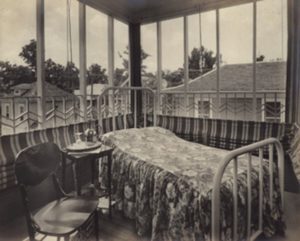
Our house is extremely symmetrical, and it has a matched pair of second story sleeping porches that are defined by grand, Romanesque arches. The porch on the east side of the house catches the sunrise, while the western sleeping porch is very hot and sunny from noon onward. Our house has a third floor that’s just above the porches. Up there, we found two places with rotting wooden strips of porch and damaged railings that indicated a rough gesture of comfort for servants. We removed these balconies, which seemed more hazardous than lovely. We put in new screens on the second floor porches and repainted and retained them, and a whole new world opened up.
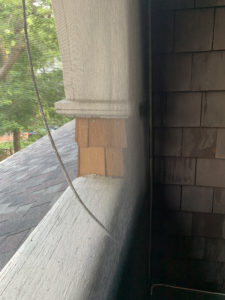
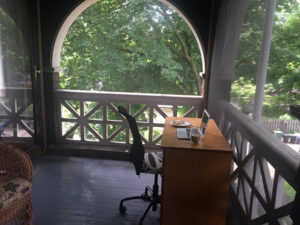
Although I can’t wait to set myself up on the sleeping porch, my back starts to twinge when I think about the floor maintenance. When I was cleaning the porch’s woodwork recently with Murphy’s Oil Soap and water, I thought of others who have done the same job the same over the last 125 years. In 1897, the neighborhood trees would have been seedlings, and without car traffic, there would be less airborne pollution. Yet, given what I’ve read in historical novels about household maintenance, the servants probably had to wipe clean the porches several times a week. I hate the pain of vigorous cleaning, but I can always stop when I want, ignoring a spiderweb or errant leaf.
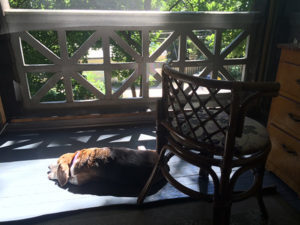
This week, I’ve made a lot of plans to clean the porch floor that have resulted in procrastination. The gray floors have so much pollen that they are pea green; not even my dog will lie down on them. After the floors are swept and mopped, I will lay down the outdoor rugs that I vacuumed before storing indoors over the winter. When I drag in the porch’s vintage rattan and wicker furniture, the porch is buzzing with energy that has nothing to do with our carpenter bees.
Year round, I do my writing in the morning; there are tables or desks in various rooms to suit my whim. On the sleeping porch, I’ve used a cheap, child-sized plywood desk from second-hand shop that I didn’t mind leaving out all year. And I got what I deserved: the old desk is starting to sag from ten years of porch life. This year, I’ve decided to junk the desk and replace it with a new desk that’s adult sized, and has iron legs and a surface made from mango wood, a sustainable, inexpensive hardwood that does better outdoors than most woods. And this desk should be nice enough to bring inside during the winter.
One piece I’ll probably never replace is an extra-long wicker chaise that I bought for $50 on Craigslist. I had a very long fresh cushion covered in outdoor fabric made for it, and now it’s the perfect place for reading, and of course, sleeping. Its generous width and high back made it extremely difficult to pass through a door out to the porch. Therefore we bring in the cushions, but not the chair, in the off-season. So far, so good.
But nobody really looks at the furniture. The best thing about the porch are views right into the high branches of the trees. I’m captivated as I see squirrels chase each other along branches and then jump like Olympic athletes to the next tree and finish up by springing onto our roof. Sometimes, a squirrel explores all the way up to the edge of the screen separating us. At the sight of me, or my tiny snarling dog, the squirrel shoots back to a safer zone.
The bird songs are quite exquisite, and I‘m sorry to admit that I can’t recognize the singers by name. When it rains, I sit in comfort while hearing the drama of falling drops and feeling the whooshing of damp wind against my skin.
When we are outdoors among trees, we go into what scientists call soft focus. The trees and sky and animals become part of a pleasant blur. Soft focus frees the dreams lurking in the subconscious.
My goal this summer is to write approximately 1000 words a day, seven days a week. Sometimes, the sentences pour out and the duty is all done by ten in the morning. Yet there are just as many days when the process is slower.
I believe the only way to overcome my writing challenges is to show up for them every day. Just like the squirrels and birds come to the trees, doing their own important work.

The post A Tree Grows in Baltimore, and So Does a Book appeared first on Sujata Massey.
April 19, 2023
A Journey with Anne Perry
This post originally appeared on Murder Is Everywhere.
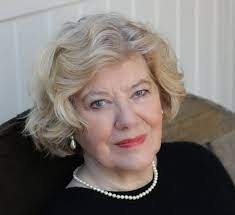
I’ve been thinking about the mystery author Anne Perry, who recently died in Los Angeles at age eighty-four from declining health. Anne wrote roughly 102 books and many short stories and essays over her forty-five-year career. The Times of London named her as one of their 100 Masters of Crime of the Twentieth Century. She was the winner of the Edgar Award, and multiple Agatha Awards, including one for lifetime achievement. She was also named the Distinguished Guest of Honor at the 2020 Bouchercon World Mystery Convention.
After a prolific mystery author dies, eulogies discussing the value of their work typically flood newspapers and social media. Yet there’s been scarcely a ripple about Anne’s death, despite her importance as one of the founding authors of the socially relevant historical mystery genre. Perhaps this is because people still can’t come to terms with Anne Perry the novelist, and Anne Perry the person.
Anne Perry is a pen name. The author was born with the name Juliet Hulme. In 1954, when she was fifteen, she and her best friend Pauline Parker, 16, committed a violent murder in Christchurch, New Zealand. Both admitted to the crime and served five-year sentences in different jails. Only their youth saved them from the death penalty.
The tragic bludgeoning death of Honora Parker has been recounted in great detail by journalists, and in a 2014 book by Joanne Drayton, The Search For Anne Perry: The Hidden Life of a Bestselling Crime Writer. The Hulmes were divorcing and moving away from New Zealand to England and South Africa, which would have broken up the girls. Pauline and Juliet envisioned Honora’s death as providing a path for the girls to stay together.
After completing her prison sentence, Juliet was released at age 20 under the condition that she never see Pauline again. Juliet legally changed her surname to Perry, that of her new stepfather, and she chose Anne as a new first name. After moving to England, she first worked at various jobs including flight attendant, limousine dispatcher, and insurance underwriter. She longed to write, and lived for some time in California, where she tried to break into screenwriting without success. In 1969 California, she met disciples of the Church of Latter-Day Saints, and she became a Mormon, an action that was to influence the rest of her life, giving her hope for personal redemption and a driving theme for the books she’d eventually write.
In 1994, New Zealand filmmakers Peter Jackson and Fran Walsh cowrote and produced the film Heavenly Creatures, a fictionalization retelling of the relationship between Juliet and Pauline, culminating with Honora’s death. The high schoolers were portrayed as lovers, something that Anne vehemently denied, although she acknowledged responsibility for her role in the crime and has said that going to prison was the proper outcome. After the film’s release, journalists tracked the whereabouts of the long-lost Juliet Hulme, and a quiet writer, now in her mid-fifties, was exposed.
 Talley, Massey, Hirahara and Perry in Los Angeles, 2006
Talley, Massey, Hirahara and Perry in Los Angeles, 2006I met Anne Perry in November 2006 in Los Angeles. Along with a number of other Sisters in Crime members, we’d traveled to take part in “Sisters in Crime Goes To The Movies”, a conference that gave writers a chance to learn about transforming books to film. Anne’s first book, The Cater Street Hangman, had been made into a film in 1998 which won an Edgar nomination for screenwriting. She was interested in having more of her work reach a cinema audience. While no more films of her books were made prior to her death, in 2012, she created a short film, Put Your Heart On The Page.
As it turned out, Anne, Marcia Talley, and I were all staying in the Beverly Laurel Hotel. The three of us visited many of the spots on the conference agenda and spoke on a mystery panel, along with Naomi Hirahara, at the Mystery Bookstore in Los Angeles.
 Talley, Robin Purcell, Rhys Bowen and Perry in Hollywood
Talley, Robin Purcell, Rhys Bowen and Perry in HollywoodI recall Anne’s friendliness, formality, and gratitude for the companionship and driving help. I liked her and was awed to meet someone who managed to be prolific while writing to high literary standards. During one conversation in the car about everyone’s writing habits, Anne estimated her typical writing schedule as twelve hours a day. This was not a boast; it was an admission of how solitary her life was in an old castle in the remote Scottish fishing village of Portmahomack.
I recently saw what Anne Perry’s private life was like when I streamed Interiors, a 2009 documentary made by Dana Linkiewicz with the cooperation of Anne. The writer speaks frankly to the camera about her life, and the film includes interview with her best friend, her driver, her secretary, and her younger brother, retired from a medical career and now helping Anne with historical research. Anne went to church on Sundays, but aside from that, her life was devoted to writing.
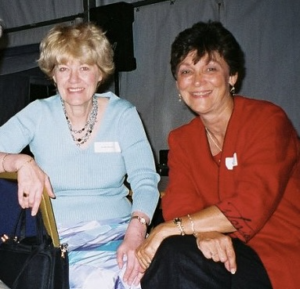 Perry and Talley, in the 1990s
Perry and Talley, in the 1990sMarcia Talley, who is grieving Anne’s loss, said their friendship began in 1995 at a St. Hilda’s Crime and Mystery weekend in England. Marcia, who was not yet published and visiting from Maryland, walked into the conference’s opening reception without knowing many people. A tall red-haired woman sipping orange juice caught her eye. Because the woman was also alone, Marcia decided to approach her.
“Anne was a wonderful conversationalist,” Marcia recounted recently. “She always listened to what I had to say with obvious interest, and later in our friendship—we attended many St. Hilda’s conferences over the subsequent years—as she grew comfortable in my company, she gradually revealed more about herself.”
A few years after that first conference meeting, Anne celebrated the publication of Marcia’s first mystery novel, Sing It To Her Bones. When Marcia’s first publisher dropped her amateur sleuth series after two books, Anne gave her advice to keep producing work for the reading public. Marcia created two serial novels, Naked Came the Phoenix and I’d Kill For That, with all the chapters written by bestselling novelists; Anne wrote a chapter in each book. In turn, Anne invited Marcia to write stories for four different mystery anthologies that she was editing.
Anne also gave Marcia advice that runs contrary to the standard advice for a writer facing cancellation.
“Anne read my Hannah Ives novels—she bought one every year at the conference bookstore, bless her! She was a great fan of the character and was confident that Hannah would live again. ‘Don’t give up on her,’ she said. So, I didn’t, and the next three novels were picked up by Morrow-Avon, and the fourteen after that by Severn House.”
Outside of conferences and speaking engagements, Anne’s life was all about writing. Out of the 102 books, none were about her personal experience with crime. Perhaps this was because Anne’s memories of the crime were blocked, as Marcia said. She also may have considered it immoral to profit by writing about someone she’d killed. Ironically, many prisons have programs where writers volunteer as teachers of creative writing. When former inmates occasionally have their writing published, they are often lauded for it. But we anticipate ex-convicts’ writing to be revealing of self. Their writing is supposed to be for healing; it’s not supposed to become a well-paying career.
Anne chose to set her writing in Victorian and Edwardian England. She made plenty of money writing gentle mysteries with exquisite sensory detail and nuanced characters. The recurring themes of kindness and a longing for redemption run through her work.
“I always felt there was a lot of Anne in her character William Monk, who suffered from amnesia,” Marcia says. “Anne told me on more than one occasion that she had no memory of the murder of her friend’s mother, but she knew that she had done it.”
I’ve read and enjoyed a few Anne’s full-length novels about Charlotte and Thomas Pitt, and I have yet to get started on her books about Hester and William Monk, those narrated by their son Daniel, and other series, including one following a family during World War I, and another that takes a heroine, Elena Standish, into pre-World War II intrigue.
I especially enjoy Anne Perry’s Christmas novellas. These tales usually start with a scenario wherein a central character is pulled away from the anticipation of holiday merriment at home with an unwelcome order to help someone far away. Strong winter weather—perhaps a blizzard, or a very rough storm—inevitably arises. The mystery unfolds, and inevitably, the wrongdoer’s reason for the crime is explained with compassion. The final scene is always about family, and the redemption of Christmas.
I find the audiobook versions, especially those read by Terrence Hardiman, exceptionally calming. If there’s a night that I feel too restless to sleep, I will play the audio version of Anne Perry’s A Christmas Journey or something similarly named. As long as it’s got ‘Christmas’ in the title and Perry on the spine, I will be off to sleep within twenty minutes.
The post A Journey with Anne Perry appeared first on Sujata Massey.
April 4, 2023
A Secret Garden
This post originally appeared on Murder Is Everywhere.

It seems amazing that two weeks ago, I was marveling at springtime in the desert. I’m back home in the Mid-Atlantic or “Delmarva,” a nickname that includes the states of Delaware, Maryland and Virginia. Washington DC doesn’t appear in the moniker, but it’s the ultimate springtime destination.
Springtime in the District is magical, with airy, pastel-colored trees and shrubs decorating the 1920s and 1930s grand architecture that marks neighborhoods like Chevy Chase, Woodley Park and Kalorama. And it seems to me that these old-fashioned, courtly perennial gardens have distinctly British layouts, but a dash of Japonisme when it comes to shrubs. Consider the original cherry trees planted in 1912 near the Tidal Basin by First Lady Helen Taft and Viscountess Chinda, wife of the Japanese Ambassador. Following this famous example, cherry and plum and quince trees were planted all over the district and the aforementioned Delmarva.
I would rather visit a private garden, with few crowds, then fight for space among thousands on Washington Mall’s. One of DC’s best kept secrets is the large formal garden behind the Omni Shoreham Hotel.
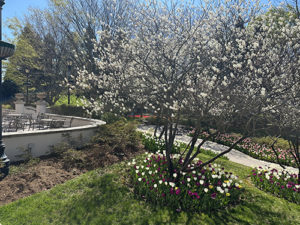

I enjoyed a lovely day flower-gazing in DC, and drove home in heavy traffic that I blame (at least partly) on cherry blossom viewers. Two hours to go 35 miles!
Fortunately, the same flora is in bloom in my own neighborhood. Daisy, our little brown terrier, walks with me several times a day. Her favorite season is undoubtedly spring. I suspect her affection is driven by the fascinating smells.


And Daisy told me that the best way to savor spring is to share it with someone else.

The post A Secret Garden appeared first on Sujata Massey.
March 23, 2023
When Writers Grow Like Cacti
This post originally appeared on Murder Is Everywhere.

I’ve just unpacked from a five-day trip to the Oro Valley near Tucson, Arizona. At a resort in the foothills, about 475 intrepid souls gathered for the Left Coast Crime convention to celebrate the art of the mystery … and also the art of the burrito, the quesadilla, the tamal.
The chimichanga’s invention is credited to a long-ago chef at El Charro, the oldest family owned-and-operated Mexican restaurant in the United States. I dined at El Charro one of the nights during this conference, as well as two other terrific local restaurants, Guadalajara Grill and Family Hacienda. All of them were unpretentious, priced reasonably, and exceptionally tasty.

I spoke on several panels and had an interview with my editor at the convention, which was a special plus of being named an author guest of honor along with the writers Glen Eric Hamilton and J.A. Jance. Judith Ann, as she was named at birth, has written at least 70 books—according to her website—and is 78 years old.

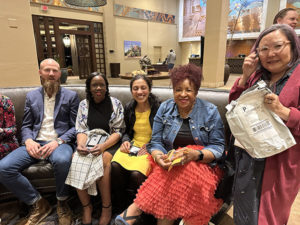
Some of my blogmates who write along with me at Murder is Everywhere came to the convention. it was a treat to spend time with Jeff Sigler, Wendall Thomas, Annamaria Alfieri, and Kwei Quartey—who was unfortunately still in transit when we took the photo below.

It was humbling to notice the massive number of people in the so-called “golden years” who spoke on panels, bought books, and schmoozed. Many of the conference’s core committee of volunteers were in their 70s and 80s. The hotel’s halls were filled with writers who began work many decades ago, or very quickly after retirement.
Arizona is known for attracting people who want to retire in warm weather with a dramatic mountainous environment. And while the ground is largely sand and rocks, hardy flowers and shrubs form a desert bloom at this time of year. Every bit of water that falls seems to be captured and turned into something of beauty.

The most ubiquitous cactus is the saguaro, native to the Sonora desert and capable of growing up to forty feet tall. I learned that these mega plants take a long time to get started: up to twenty years to grow the first twelve inches. However, they may live more than 150 years, and sometimes have upwards of 50 arm-like branches. Mature saguaros can weigh three to four thousand pounds, weight that comes from being filled with water that slowly feeds their own growth and the host of animals and insects that come to them for sustenance.
The saguaro cactus, a column of strength with an undetermined, individual journey, reminds me of the slow process, and many offshoots, in becoming a writer.

The post When Writers Grow Like Cacti appeared first on Sujata Massey.
March 8, 2023
The Seed of a New Story
This post originally appeared on Murder Is Everywhere.

We are emerging from a strange winter in North America. Recent snowfalls have shocked California and Arizona, while there was no virtually no snowfall in Maryland. The temperatures here in Baltimore were so mild that the ground could be dug in early January for the planting of trees. I’d hoped for snowfall to bring them water—but at least there was some rain.
 First cherry display on my street
First cherry display on my street The second year appearance of my hellebore transplant
The second year appearance of my hellebore transplantAll over the east and south-east, spring activity began ahead of schedule. Cherry, magnolia, quince and plum trees are in bloom. In my garden, daffodils and hellebores are showing their faces. A chillier vibe is forecast, but I’m already in “the trenches” planting seeds.
Seed gardening is my new pastime. Typically, I sit around until May, and then I dig in transplanted seedlings from gardens or nurseries. Perennials are my favorite, because if I’ve gone through the drudgery of weeding, I’d rather fill those spaces with beneficial plants that will spread their roots and make my gardening life easier in years to come.
This year, I fell prey to seed catalogs and seed company websites promising perfect mixes for pollinating insects and birds. Who can resist the allure of the elegant botanical illustrations on paper seed packets? I certainly can’t—and I swoon over these flowers’ elegant Latin names, like cosmos, helianthus, calendula, and lobularia. Don’t these names fit heroines in an upcoming season of Bridgerton? Even more racy are the varietal names made up by growers: Orchid Cream, Milk Maid, and Black Velvet. These are just a few of the varieties of nasturtiums that I’ve ordered from John Scheepers Kitchen Garden Seeds. Because these flowers are annuals, my plan is to plant them in pots and the ground near any vegetables and flowers that attract aphids—and to eat whatever blooms they miss in salad—or better yet, on top of cake!

Another advantage to seed gardening is the vast number of seeds per packet at a bargain price. Not all the seeds will grow into flowers, but some will reward me this year, and surely grow their flower families in upcoming years. I refrigerated and soaked some seeds, per directions, to help them get in gear.
The process of throwing seeds into earth reminds me of the way I write. When I start a new book, I never start on Page One. Before that, I ponder the many notes that I’ve taken from reading and brainstorming. I also list places I need to visit to learn important things for the book and write down the names of experts I’d love to interview, either in person or through e-mail. I prepare the ground.
A huge challenge that comes next is the arrival of emerging weeds, which look so innocent when only one inch tall. How can I possibly tell an emerging weed from a baby coreopsis? My phone has an app, Picture This, that can name most plants, whether desirable or not. Sometimes I just let the weed or flower keep growing before I decide what to do.It’s a guessing game, just like when I’m rolling along in my book’s narrative. And when I garden, my thoughts are often on my book.
I can write faster when it’s easy to look at synopses and notes. A word processing program called Scrivener helps me store these inspirations and reminders on digital index cards that are kept close to each chapter. In the garden today, I was planting lupines just ¼ inch under the soil. Nearby, I placed wooden sticks with their names, so they aren’t overlooked or, worst of all, weeded!
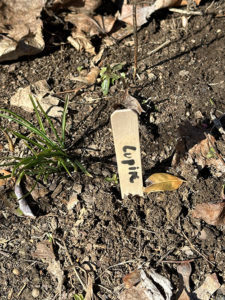
When I’m involved in a book I ramble, letting conversations unfold as they will. I’m the first to admit that these explorations lead to what I call “over-writing.” These trailing vines and redundancies can choke the life out of the novel’s central structure; but I can’t see it until the first draft is complete. Then, I begin to thin out sentences and paragraphs, just as I’ll have to lift out some baby seedlings to provide enough mineral resources for the others. I can move some of the banished babies to other spots in the garden—just as I sometimes shift scenes in a book, or details about people. Although whether they will live is yet to be seen.
In my July 2023 release, The Mistress of Bhatia House, I’d written a scene with an Indian family eating a particular regional fish nicknamed Bombay Duck as part of a large breakfast. Reflecting on it, I realized the fish would be no big deal for the Mistrys, but it could play an amusing role if served to someone else. My redo had Perveen’s friend Alice Hobson-Jones enjoying Bombay Duck at the Taj Mahal hotel, and the dish becomes a commentary on 1920s colonialism.
My Bombay Duck swap reminds me that a big part of both writing and gardening is impulsivity. The ambitious screenwriter making a first appearance in my work-in-progress suddenly got upstaged by a much more intriguing assistant cameraman. It’s early enough in the writing process that I can delete one character for the other, thus avoiding one of my classic writing problems: too many characters!
A few days ago, I was in a nursery and noticed a thick bag of Dutch clover seeds. And in a moment, I realized that flowering clover could fortify my anemic lawn. Clover deposits nitrogen. It also crowds out weeds and feeds insects and animals. And the best part is that it’s not too late in the season to scatter this seed.
Although I consider myself a writer who gardens, I don’t always wake up eager to create on paper or in the earth. But I know that gardening outdoors sends Vitamin D into my body and raises my mood. Putting my fingers on the keyboard and banging out a few paragraphs provides a similar release. Relaxation and pride always follow a writing session.
A cosmos bloom might be tiny, but when massed together with others, it has a vast impact. I believe there will be thousands of individual flowers, small and large, in my garden this spring and summer. I’ll let you know whether the words follow.
The post The Seed of a New Story appeared first on Sujata Massey.



